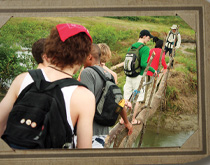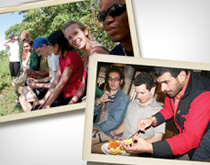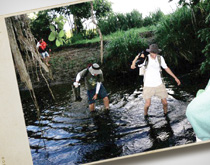
Carlton Reeves was already struggling to stay awake on the bus. It was going to be a long ride ahead for him and the 11 other Carnegie Mellon students in his group—eight hours bumping along jungle roads to get around the mountain as the bus made its way from Quito, Ecuador, to the Congal Biomarine Reserve, which is on an island just off the South American country's Pacific coast. Night had already fallen, and there wasn't all that much to see. But in a way, that was the point.
The darkness veiled the tangle of tropical brush edging the road for mile after lonely mile. But suddenly a groggy Reeves would see a hotspot of bright light pop up out of nowhere. The bus had come to a town. It was Saturday night and everybody, he thought, seemed to be at the one local hangout. The rest of the town and surrounding countryside was dark, but here it was like a spotlight shining on the people laughing and talking and having fun.
Then the bus moved on, and again it was all darkness and miles of desolation until he could see the next little settlement blinking in the distance, like a star come to alight on the earth.
The draining, sometimes jolting bus ride into the night came after a full day of touring Quito, Ecuador's capital city. And that came on top of the 2,700-mile flight from Washington, D.C., with a layover in Panama. It was a long time and a world away from the restaurant near Carnegie Mellon's campus in Pittsburgh where everyone had met up for a late dinner before pushing off at midnight for the drive to Dulles International Airport. This was the first day of spring break for Reeves and his classmates, and it promised only to get more intense once they reached the reserve—because this was no ordinary lay-around-all-day-in-the-sun, party-till-the-wee-hours kind of spring break trip. They would see a little of Ecuador's beautiful Pacific coast, but time on the beach would be the punctuation to a long day of hacking away with machetes at the overgrowth on the edge of the jungle or helping local farmers harvest bananas. Welcome to Alternative Break.
Alternative Break is a concept taking off at many colleges and even some high schools around the country. Students forgo the usual week of vacation or plain-old catching up on sleep to immerse themselves in a community service project, often run by nonprofits such as Habitat for Humanity.
What's different at Carnegie Mellon is that students have the opportunity to participate in their own student-led organization called, appropriately enough, Alternative Break. Nuveen Marwah (HS'06, TPR'06), now a sales and trading analyst at Deutsche Bank in New York City, established the club in 2005 by making it his project as a fifth-year scholar. Brad Miller, a founding member who succeeded Marwah as Alternative Break president, points out what it means for the students to take full responsibility for the venture: They do the research and choose the trip, look for funding, determine travel requirements, and explore what they should know about the region, culture, and environment. "It's not heavy lifting, but it does require a fair amount of planning," says Miller, a senior electrical and computer engineering major with a Spanish minor.
The alternative breakers have done muscle-aching labor by helping clean up homes ravaged by Hurricane Katrina in the town of Bay St. Louis, Miss. They've also been a part of humanitarian efforts by working alongside the Border Angels in San Diego to provide life-saving supplies of food and water for those crossing the border. But the trip to Ecuador was perhaps their most ambitious yet as it was the group's first project flying beyond the United States' borders.
Their chosen destination was the Congal Biomarine Reserve, which is operated by the Jatun Sacha Foundation, a private Ecuadorian organization dedicated to the conservation of natural resources and promotion of sustainable development practices. The Congal Reserve is part of a region designated as a biodiversity hotspot, which means a rich variety of plant species particular to that region are being threatened.
"We thought the reserve was very promising in the sense that they were relatively established," says Miller. "They had been in the habit of hosting volunteers. When we called, they answered the phone in English, which suggests a certain degree of competency in dealing with foreigners. They seemed to be a reliable group, and when you're sending people to Ecuador, you prefer things to go as smoothly as possible. We value that."

Miller knows firsthand the vicissitudes of traveling with a group. On the organization's inaugural trip over winter break 2006 to Bay St. Louis, he found himself stranded in Buffalo, N.Y., when an ice storm shut down the airport. The travel plans had been complicated to begin with—trip participants flying in from other airports; converging in Cincinnati, Ohio; flying from there to Jackson, Miss.; and then driving six hours the following morning to their final destination. They had all gotten to where they should be, with the exception of Miller, who just happened to be one of the trip co-leaders. To catch up with everyone, he engineered a plan that involved flying into a different airport the following morning and convincing an airport shuttle to drive him an hour-and-a-half, which included crossing a 26-mile bridge, and then leave him at a Holiday Inn along an interstate, where the van of in-transit alternative breakers could swing past and pick him up. "After that, no multiple airports," Miller says.
Paying for the trips, by the way, involves more than car washes and bake sales. The officers of the club make formal written proposals to offices and departments within the university that have the power and resources to award funding. Last spring's trip was underwritten in part by Carnegie Mellon's Student Senate, the Office of the Dean of Student Affairs, and the Modern Languages department. Even though Alternative Break students are doing volunteer work, the people they're helping can't shoulder the expenses of housing and feeding them, so significant costs are involved. The students end up paying for about half of the trip, which, Miller says, usually comes down to the airfare.
The Modern Languages department, with Hispanic Studies Associate Professor Kenya Dworkin as the faculty point person, helps justify the students' contribution by offering credits when trips are relevant to the department. Specifically, the department looks for trips that enhance communication while fostering an appreciation for the attitudes, values, and traditions of the groups whose languages the students are taught in Pittsburgh.
Students who sign on are expected to produce a final project that reflects on their experiences through whatever media they choose. Alternative Break is offered at the 200 level for those whose final projects are in English and at the 400 level when a project is in the locale's native language. "More people are paying attention to the culture of volunteerism," Dworkin says. "This is one way the university can give value to service learning in the humanities."
Sure enough, because the Alternative Break excursion to the Congal Reserve was the group's first trip exclusively outside North America, it created a new set of challenges. When the dean had a question Miller couldn't answer—for instance, what were the dinners on the coast of Ecuador like—Miller, as president, would have to go to trip leader Elizabeth Chen, who in turn would contact the people in Ecuador. "But you don't actually call the reserve," Miller says. "You call the central office at Quito. Eventually word makes its way out to the coast and then has to trickle way up. So every time somebody thinks of a new question, you should plan on about 10 days for an answer. There's only so many times per cycle for more questions before you start to run out. That aspect is nerve-wracking. To maintain the timeline that we knew we had to, we had to do things like advertise the trip before we were sure the trip would be possible. It's not really a situation you love to put yourself in."
Another issue that presented some additional difficulty had to do with paying an organization in another country. "Some organizations are particular about how you can pay them," Miller says. "You can't just take a Tartan card to Ecuador with $5,000 on it."
And then the whole trip was almost scuttled about 10 days before the departure date when the Colombian army chased a band of guerillas across the Columbian border and shot them on Ecuadorean soil, which of course put the Ecuadorean military on alert. The Congal Reserve is only 40 miles from the border. However, the Jatun Sacha Foundation was able to provide assurances that no armies were amassing there, so the trip went on as scheduled.
THE GROUP'S BUS finally arrived at the reserve around two in the morning. The man in charge, who was born and raised in Ecuador, showed them around their accommodations, including the single shower (no hot water!) that they would have to take turns using. Someone wanted to know if the chickens outside the building belonged to the reserve. "Ja," their host replied. "At least there aren't any roosters anymore." Then he sent them off to bed, suggesting they meet in the dining room downstairs at eight o'clock.
The real work would begin Monday. Sunday they would spend touring parts of the reserve and trying to fend off mosquitoes. Miller would later describe the area as heavily wooded—"meaning if you walked through the woods for an hour, you would be pulling bugs out of your hair." That first day, they hiked through the tropical forest to the coast. The station is not too far from the ocean, but between the two are shrimp ponds among mangrove islands arising out of saltwater swamps. The islands consist of woody plants with tangled roots that grow above the ground as well as below it. They aren't easy to walk on, but they're nature's way of providing a habitat where fish nurseries can flourish. They also offer a natural line of defense from hurricane-force storms and help to prevent coastal erosion. All in all, mangroves are pretty formidable. But they're still no match against bulldozers and modern commercial shrimp farming interests, which made a pretty penny by converting much of the land along the coast and in the mangrove swamps to shrimp farms. That aquaculture industry thrived for awhile, until a virus swept through the shrimp population and the large commercial interests pulled out. Not much of the profit trickled down to the local economy, either, whose natural resources had been used up.

This is where the Congal Reserve came in. It is replanting mangrove habitats that have been destroyed, which is helping give shrimp a chance to thrive there again, and it is developing modern farming practices for local—not commercial—shrimp farmers that are healthy and sustainable for the shrimp and environment.
In the middle of the week, the alternative breakers would return to the reserve's shrimp ponds to harvest the shrimp for local farmers, pulling the shrimp up in buckets from the nets until canoes were filled with shrimp. "It took our whole group of volunteers and another group from Maine—it took all that manpower to collect all of the shrimp. There were tons and tons," says Reeves, now a senior mechanical engineering major. "I have never seen so much shrimp in my life. I remember I tried to pick one up, and I never knew that shrimp were sharp. It cut right through my skin with little fins that were sharp. And it jumped around. We even caught a couple fish that were in the water. It was real busy and a lot of work, but it helped out a lot of the people in the village."
Over the course of the week, the Carnegie Mellon group also helped local farmers harvest bananas and tagua nut. Harvesting bananas was hard work on several fronts. "Everything is really hilly there at the banana plantation," Reeves says. "You walk up this hill to get to the little farm on the top. It is very small—a house, a barn, a couple horses. Then you have to walk down this really steep hill—it was like a maze with banana trees growing all over the place. [The farmers] cut a branch and tie it up like a sling bag and give you a whole bunch of bananas to fill it. Once you have one or two of these on your shoulders, you have to walk up this ravine carrying 80 or 90 pounds of bananas. It was crazy."
The tagua harvest was not quite so hard on the body. The tagua nut—often called vegetable ivory and used for buttons and for artisanal carving—is usually found on the rainforest floor, which can be steep and muddy. A full sack might weigh 10 or 12 pounds, estimates Chen, now a senior biology major.
No matter the task—one day they even used machetes to clear a pasture—the volunteers were exhausted by day's end. "We existed sun up to sun down," says Chen. "There was no electricity at night. They shut it down because bigger towns needed it."
It wasn't all work and no play, though. Siesta each day lasted from eleven to two—a practice Chen says she wouldn't mind cultivating. Some would head to the beach after working. Reeves somehow found the energy to hightail it to a neighboring village and play soccer with the kids.
The vacation-that-wasn't-a-vacation was so rewarding for Reeves that he is now president of Alternative Break. He and the other club members are organizing two spring Alternative Break trips this year: one to St. Bernard Parish, La., just outside of New Orleans; the other to the rural community of San Pedro de Casta, Peru. Reeves hopes the students on both trips experience afternoons like the one he and his classmates had in Ecuador when they stopped in a community center in the nearby town of Muisne.
Dancers at the center were performing a traditional Afro-Ecuadorean dance—the women, visions in flowing white skirts and tops, sashaying around the men, who wore white pants and sleeveless tees. When they finished the performance, they tried to pull the college students into the dance line. One of the students, Blake Coughenour, a junior physics major, caught the scene on video and found it so "uplifting" he used it to conclude the video he produced for his final project. It's easy to see why. Some of the students tried the steps, others just moved to the pulsing music. Eventually they were surrounded by smiling, laughing children who danced and hammed it up for the camera—as children everywhere in the world do—until one little hand got closer and closer to the jiggling lens and blocked out the picture, but not the good vibe of two worlds meeting.
Sally Ann Flecker is an award-winning writer whose work appears regularly in this magazine.



